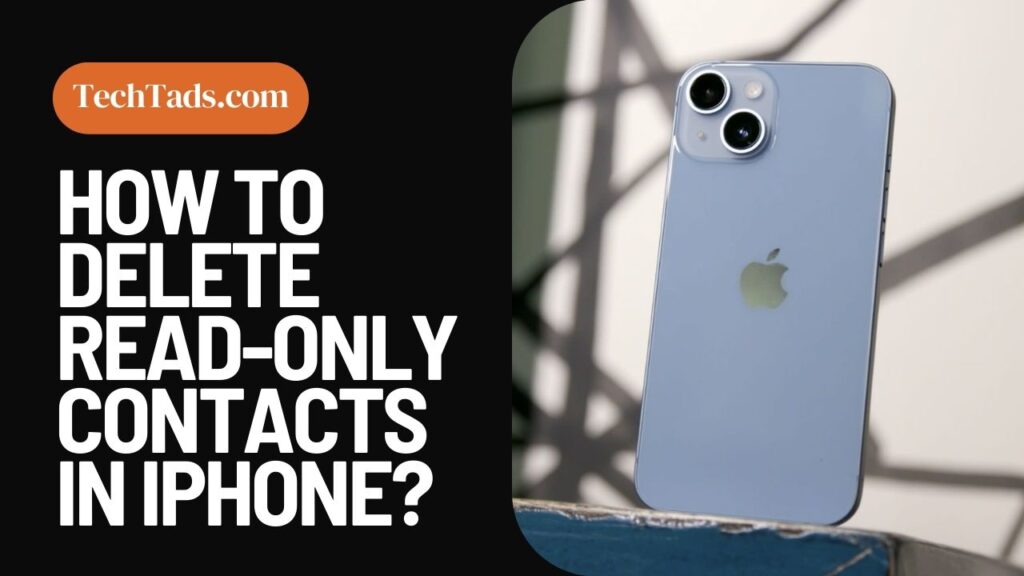What is ready only? This word shows up when you are deleting some files but the system doesn’t allow you to do so. You can only read the files. You can neither delete it nor edit it.
Now I’m curious about what read-only contacts are. Contacts saved via third-party applications are known as read-only contacts. These contacts frequently show up in your contact list and are stored temporarily in the device’s storage.
Unfortunately, you cannot directly delete these read-only contacts. These contacts are like a locked door; you can look through them, but you cannot change anything inside them without permission.
This error might be very confusing, with no potential solution.
How to delete read-only contacts on iPhone?
Many iPhone users have reported the pop-up error message “read-only contact” when they tried to delete a normal contact. There is no permanent or fixed solution; it can be done by different methods according to the situation.
It can be done only by turning off the third-party program’s sync feature or by uninstalling the application altogether.
This article will surely help resolve this issue. Here are the steps you can follow:
How to manage contacts on iPhone
Disabling and re-enabling iCloud Contacts sync will help you resolve the “Not All Contacts Were Deleted” problem if you’re having issues with the accuracy of your iPhone contact list. This is how you can do this:
- Get your iPhone’s Settings app open.
- At the top of the screen, tap on the name of your Apple ID.
- From the list of options, pick “iCloud”.
- Scroll down and click “Contact” when you see it.
- Toggle off ”Contacts” so that it gets disabled.
- Once this is done confirm deleting your contacts from your iPhone. Don’t worry as you will not lose them forever as they are still stored in iCloud.
- Just restart your phone and go to settings again and click your Apple ID.
- Go to iCloud then contacts.
- Now, you just have to turn ON the iCloud contacts and try deleting the contact.
How to remove contacts from iCloud
If disabling or re-enabling contacts doesn’t work out for you, you can try another way.
The second way to delete read-only contacts from the iPhone is to delete them from iCloud directly. To do this, follow these steps:
- Go to iCloud.com using any browser and log in using your Apple ID and password.
- Select the contact you wish to remove from the Contacts app and click edit and then the “Delete” option.
- On the next screen, confirm that you’re certain you want to remove the contact.
- Check the Contacts app on your iPhone once again to see whether the contact is still there.
- If it isn’t, the contact has been successfully deleted.
Delete read-only contacts from the associated account
The final solution to this problem is to delete the contacts from the associated accounts like WhatsApp, Viber, Skype, or Google Contacts.
Some iPhone users have reported the problem that they cannot delete the contacts because they are associated with other programs. To do so, you must also delete the chat with this contact.
- Open WhatsApp, choose the Chat tab to find the conversation with this contact
- Swipe the conversation from right to left, and then select More… ->
- Clear Chat from the WhatsApp chats main view.
You may use WhatsApp Pocket to have your contact backup and export all WhatsApp conversation data, including chat messages, media files, and other data, before deleting them if you don’t want to lose the chat’s contents.
Or you can choose the alternative to this.
- Go to the Settings app and choose “General.”
- Press the “Reset” button, then choose “Erase All Content and Settings.”
- Before you do this, make careful to back up your data because it will wipe all of your data from the device.
- You can reinstall any applications on your smartphone when the reset is complete, including the app where the contact was stored.
- Check your iPhone’s Contacts app. It must already have been successfully deleted.
Third-party applications
To effortlessly remove all read-only contacts or other contact groups, you may also use the help of third-party Contacts cleaning programs.
- Check out the App Store.
- Try looking for a contact-deleting app. Pick the one with the best rating and download it.
- Give permissions to the app from iPhone’s settings.
- To delete a contact, select it and tap “Delete.”
Apple support
You may always get in touch with Apple Support if you’re sick of the “Not All Contacts were deleted” pop-up.
To find the answer to the issue you are having—in this example, how to delete read-only contacts—you can either search for your query there or select Get Started.
Restore contacts
Fone Rescue is an application for recovering lost iPhone contacts. This enables you to export contacts or help in retrieving them from the iPhone device with or without an iPhone backup if you accidentally erased some iPhone contacts.
Clearing cache
Clearing the cache is another method for getting rid of read-only contacts from your iPhone.
- Open the Settings.
- Select “General.”
- Click on “iPhone Storage.”
Tap “Contacts” next, then select “Offload.” After that, launch the Contacts App and remove the read-only contact once more. Most of the time, it will work.
You may have restrictions if you can’t quickly remove the contacts through settings and iCloud. If so, you must remove these restrictions to delete the read-only contact. This is how:
- Click “Settings.”
- Select “Screen Time.”
- Click “Content & Privacy Restrictions.”
- Next, enable it to allow changes upon contact clicks.
Duplicate contacts
While resolving the issue of read-only contacts, the other common error is of duplicate contacts.
By choosing the Link Contacts option and selecting each important duplicate contact from the list, you can alternatively combine all the duplicate contacts into a single contact profile.


